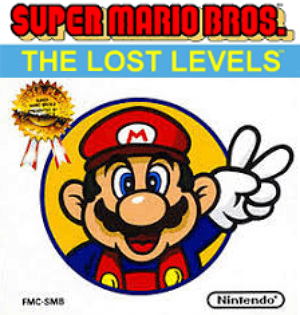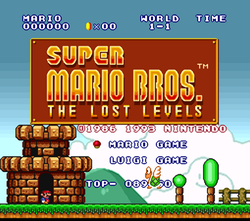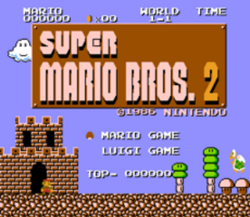Super Mario Bros.: The Lost Levels: Difference between revisions
(remove categories) |
(move out Deluxe) |
||
| Line 48: | Line 48: | ||
[[Category:Video games developed in Japan]] | [[Category:Video games developed in Japan]] | ||
[[Category:Video games included in Super Mario All-Stars]] | [[Category:Video games included in Super Mario All-Stars]] | ||
[[Category:video games published by Nintendo]] | [[Category:video games published by Nintendo]] | ||
Revision as of 05:14, 11 December 2023

| |
| Super Mario Bros.: The Lost Levels | |
| Developer | Nintendo R&D4 |
|---|---|
| Publisher | Nintendo |
| Platforms | FDS, SNES, GBC, GBA, Wii, 3DS, Wii U, Nintendo Entertainment System – Nintendo Switch Online |
| Released | Famicom Disk System Japan: June 3, 1986 SNES/Super Famicom (All-Stars) Japan: July 14, 1993 North America: August 1, 1993 Europe/Oceania: December 16, 1993 Game Boy Color (Deluxe) North America: May 10, 1999 Europe: July 1, 1999 Japan (Nintendo Power): March 1, 2000 Game Boy Advance (Classic NES Series) Japan: August 10, 2004 Wii (Virtual Console, FDS) Japan: May 1, 2007 Europe/Oceania: September 14, 2007 North America: October 1, 2007 Nintendo 3DS (Virtual Console, FDS) Japan: July 25, 2012 Europe/NA/Oceania: December 27, 2012 Wii U (Virtual Console, FDS) Japan: August 8, 2013 Europe/Oceania: January 23, 2014 North America: March 13, 2014 Nintendo Switch (Online) WW: April 10, 2019 Game & Watch: Super Mario Bros. WW: November 13, 2020 |
| Added to Museum |
Wii All-Stars: January 20, 2012 SNES All-Stars+World: December 19, 2018 Game & Watch (FDS): March 12, 2021 |
Super Mario Bros.: The Lost Levels was a game in the Super Mario series. It was the direct sequel to Super Mario Bros.. It was released for the Family Computer Disk System, only in Japan, as Super Mario Bros. 2 in 1986. It used the same engine as Super Mario Bros., but it had several new gameplay elements that made it a much more challenging game.
Originally, Nintendo thought the game was too challenging for American gamers and opted to convert Dream Factory: Doki Doki Panic into a Mario game instead. The result was Super Mario Bros. 2, which was released in Japan as Super Mario USA. When Japan's Super Mario Bros. 2 eventually did make it to overseas markets, it was retitled Super Mario Bros.: The Lost Levels or Super Mario Bros. For Super Players to differentiate it from the game that was released in those markets as Super Mario Bros. 2.
Story
An Italian plumber named Mario, or optionally his brother Luigi, once more have to travel across the Mushroom Kingdom on a quest to rescue Princess Peach from King Koopa, who has kidnapped her again. They have to once again travel across eight different worlds within the kingdom, collecting power-ups to help them along the way, on their quest to rescue the princess.
The first seven worlds have a castle where one of King Koopa's minions is disguised as their king, and beating these foes will reveal their true nature. Then, upon reaching the dungeon, Mario discovers one of the many Mushroom people that inhabit the Mushroom Kingdom. Each Mushroom person that Mario meets tells him that the princess is in another castle.
Finally, upon defeating King Koopa at the castle at the end of the eighth world, Mario finally rescues Princess Toadstool and once again restores the fallen Mushroom Kingdom to its former glory.
Development
Shigeru Miyamoto and his team at Nintendo R&D4 rearranged some levels from Super Mario Bros., and designed new levels, for VS. Super Mario Bros.. They did this in order to make the game more difficult for the arcade market. Miyamoto stated that the development team had so much fun making the harder levels for VS. Mario Bros. that they decided to create Super Mario Bros. 2, which would be known as Super Mario Bros.: The Lost Levels when it was released outside of Japan.
Versions
The game was first released as Super Mario Bros. 2 on the Family Computer Disk System in 1986. It has since been released on many different systems, both through traditional game ports and through emulation. It received an enhanced port for the Super Nintendo Entertainment System as part of Super Mario All-Stars in 1993. Outside of Japan, it received the title The Lost Levels to differentiate it from Super Mario Bros. 2, which was released as Super Mario USA in Japan.
In 1998, five worlds from the Super Mario All-Stars version, with exclusive overworld maps, were included in BS Super Mario Collection for the Satellaview broadcast satellite add-on for the Super Famicom.
It was ported to the Game Boy Color in 1999, as Super Mario Bros. For Super Players, as part of Super Mario Deluxe.
The game has also been re-released through emulation. The Famicom Disk System version was released on the Game Boy Advance as part of the Famicom Mini Series. The Famicom Disk System version of the game was released for the first time outside of Japan as part of the Virtual Console service on Wii in 2007. Super Mario All-Stars was re-released for the Wii as Super Mario All-Stars Limited Edition in 2010. The Famicom Disk System version of the game was then released for the Virtual Console service on 3DS in 2012 and on Wii U in 2013. Super Mario Deluxe was then released on the 3DS Virtual Console in 2014.
The original Famicom Disk System version was then released as part of the Nintendo Entertainment System – Nintendo Switch Online service for Nintendo Switch in 2019.
It was also included, along with Super Mario Bros., and Ball, in a Game & Watch handheld video game console in 2020.

